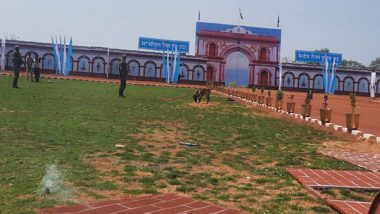Bastar, March 26: Working in tough weather conditions and rough terrain across India, the dogs of the Central Reserve Police Force (CRPF) have played significant roles in foiling major terror as well as Naxal incidents by recovering around 5,000 kilograms of explosives in the country and saving the lives of brave security personnel.
However, not everyone may be familiar with how these canines are keeping their lives at risk during operations being carried out by CRPF personnel at terror-hit regions as well as the districts affected by Left Wing Extremism, the dogs being trained at Dog Breeding and Training School (DBTS) of CRPF in Bengaluru are acting as a force multiplier and thwarting untoward incidents.
"Since their deployment across the country, these dogs have helped CRPF personnel in recoveries of collectively around 5,000 kilograms of explosives. When a half kilogram of explosives can claim a large number of lives, one could imagine the extent of damage such a quantity (referring to the number of explosives recovered) of explosives can cause. These dogs have saved the lives of several security personnel," said Deputy Commandant of CRPF's DBTS Mahendra M Hegde while speaking exclusively with ANI on the sideline of CRPF Day celebrated in Chhattisgarh's Jagdalpur on Saturday. Chhattisgarh: Naxal Couple Carrying Cash Reward of Rs 8 Lakh, Involved in Deadly Attacks, Arrested in Sukma.
Out of the total recovered explosives, 80 per cent were recovered from naxal-hit districts in the country, the officer added. So far, around 500 dogs are deployed in insurgency-hit districts of Chhattisgarh, said Hedge, adding that more will be needed."Presently, the dog authorization in CRPF is very high as compared to other forces and right now, we have the authorization of 1500 dogs.
The reason for this is the nature of our duty, particularly in naxal-hit areas. The number of dogs that we have now is not enough and much more are needed because the canines are to be deployed for dealing with new challenges.
Deployment of dogs has benefitted us as a force multiplier because they lead the troopers in operational areas," the officer explained.Deputy Commandant further informed that BDTS in Bengaluru was established in 2011 realising the importance of dogs in operational activities. First, we introduced Belgian Shepherd and Dutch Shepherd breeds and trained them to be multitasking.
The training school has trained a thousand dogs and deployed them at various places across the country, be it Jammu & Kashmir, Jharkhand, Bihar, Odisha or other parts. The school trains dogs to signal early warning of ambush, detection of IEDs and deal with anti-national elements. These dogs are deployed in the security of vital installations as well.
When asked about the selection of only these two breeds of canines, the Deputy Commandant explained that CRPF is usually deployed in tough areas like Chhattisgarh and Jammu & Kashmir where the weather conditions are adverse and duty hours are also long. We found the breed Belgian Shepherd fit for the job and recently, Dutch Shepherd is introduced in the force which can meet our requirements.
"Labrador and German Shepherds which are usually in India are not of working line. The working capabilities of these two breeds did not meet the requirements of our force," the officer added.Detailing about the training, the officer further informed that DBTS is such a training school where the dogs as well as troopers are being trained. 44th Battalion Indo-Tibetan Border Police Recovered a Naxal Dump.
The handlers have to learn human as well as animal psychology because after training completes and a canine is deployed with a unit, a handler is everything to the canine. The handlers have to look after the training, health management and use during the deployment of their respective dogs. When a puppy is 30 days old, it is separated from its mother dog and handed over to the handler.
After two months of foundation training, the handler and dog are subjected to the next level of training. For each dog, we have two handlers so that others could handle it in the absence of one.
Speaking about the recruitment and retirement provisions for a canine in the force, Hedge said after the training is completed, the dog as well as its handler is deployed in tough areas and later, the posting is given as per the choice of the handler. There is a clear guideline for the retirement of these canines, after a dog completes 8 years, a board is constituted to check its fitness and if found fit then working is extended for a period of one year.
"After retirement, the canines are kept at the school itself and provided 70 per cent ration (as compared to its working time). Till the last breath it is being taken care of with respect," the officer explained.
(This is an unedited and auto-generated story from Syndicated News feed, LatestLY Staff may not have modified or edited the content body)













 Quickly
Quickly





















